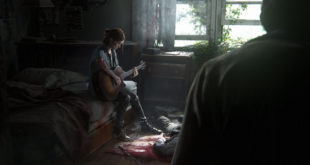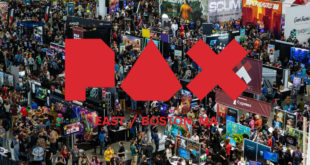In this exclusive extract from Ballistic’s The Art of Uncharted 2: Among Thieves we go behind the scenes to see how Naughty Dog made the cinematic sequences in one of this generation’s most dramatic games.
Cinematics
Naughty Dog’s creative director Amy Hennig talks us through the making of Uncharted 2’s cinematics...
"Because we’re telling a character-driven story, capturing the emotional authenticity of the actors’ performance is key. Everything we do, all the processes we’ve developed, are geared to this one goal. It all begins with the story and writing, of course, but after that our primary and most critical hurdle is casting.
We cast Uncharted as though we were casting for film or TV—including in-person auditions, and callbacks where we have the principal characters read with Nolan North, our lead.
It’s important that we not only find talented actors for the roles, but the chemistry has to be right. It’s also critical for us to assess the actors’ physical signatures, because they provide the entire performance for their characters—including both motion-capture and dialogue recording."
"Unlike most other game developers, we have the actors performing together on the mocap stage, so it’s really much more like a theatrical or on-camera performance in that way; it’s sort of like going back to the actors’ roots and doing ‘black box theater’.
We’re also recording the actors’ vocal performance at the same time, because we mocap the scenes on a sound stage, and we have the actors mic’ed for sound. Even when we’re recording in-game audio in the voice studio, we have the actors performing together whenever possible.
Any actor will tell you that acting is reacting—so it’s ironic that in most game productions, the actors are performing alone in the recording studio without any real context, and without the other actors to play off of.
That’s why we’ve developed the production methods we use—having the actors on the stage together allows them to capture those ‘lightning in a bottle’ creative moments, which give their performances such a natural quality, and so much emotional authenticity. We’re able to capture every little stumble and overlap, every interruption and ad-lib that brings the characters to life."
"We also include the actors as long-term collaborators on the project—we work together for more than a year, we revise and table-read and rehearse the material together before we capture it, and we allow for a lot of collaborative improvisation on shoot days.
Capturing the cinematics for Uncharted is more like shooting an on-camera production than a video game. It’s like shooting a multi-camera TV show, because the actors perform entire scenes in a single take—we don’t have to break the scenes down into shots because the mocap cameras record the entire performance from all angles simultaneously. All the camera staging and editing happens later, in Maya, when we get the mocap data back and the animators get to work.
We’ll only break a scene into multiple shots if the size of the mocap stage can’t accommodate the entire scene, or if we need to break down the set for some reason. Otherwise, we just let the actors run the scene all the way through."
"We’ll usually do several takes, just to make sure have enough choices when we get to the editing process, and to allow for some alternate readings and improvisations. The actors really enjoy the process, because it takes them back to the roots of their craft.
We also like to work fast and keep things moving, so there’s not a lot of waiting-around time. And it’s a pretty forgiving medium, since we can easily cut together different audio and mocap takes to fix any problems, more so than we’d be able to do if we were shooting for film or TV.
Ultimately, we carry the Naughty Dog philosophy into the mocap studio—which is a check-your-ego-at-the-door, no BS, collaborative working environment which the actors enjoy. There’s a lot of camaraderie, and it’s a very relaxed set, not a lot of tension—all of which shows, I think, in the end result.
‘Last Year’s Model’, where Drake and Chloe meet Elena and Jeff, was not only one of my favorite scenes in the game, but one of the hardest to produce.
The first challenge was choosing the mocap data, which was culled from many different takes for each actor. The camerawork also proved tricky, as the actors were often walking around and crossing the camera plane.
The animators had their work cut out for them as well. There was lots of physical contact between the characters, lots of prop animation, and some of the most demanding facial animation in the whole game. Chloe in particular was a challenge in this regard, as she had to cycle through a wide range of emotions."
Motion Capture
Cinematic Animation Lead Josh Scherr talks us through
the motion capture process for Uncharted 2
"We approach motion capture quite differently than most studios. While we do extensive planning prior to the shoot, we don’t do storyboards. We discovered early on that planning out all the shots ahead of time was not only unnecessary, but didn’t allow for all the spontaneous discoveries (and inevitable changes) that happen during rehearsal and shooting.
We’ll sometimes do rough camera blocking for scenes with elaborate setups or a lot of characters. We spend most of our prep time measuring our game environments to make simple physical sets, coming up with rough staging, and making props.
On the day of the shoot, my job is to make sure the animators get everything they need to create the best possible performance. Getting video footage is absolutely vital.
Not only does it help me pick the best performances from each actor, it provides the animators with essential reference. We don’t do any facial mocap—all of the faces are animated via keyframing—so three of our four cameras focus on the actor’s faces, and the fourth camera acts as a master overview of the scene."
"I also try to make sure the actors don’t make any performance choices that won’t read well once applied to their characters. After the shoot, I review the best takes and choose what mocap I want to use.
Since there’s rarely a completely perfect take, I usually mix and match the best takes from each actor to make the final scene. Once we receive the data, the real work begins. We don’t just take the raw mocap, drop it into the game, and call it done. Everything is carefully edited, modified, and polished."
Animations
Cinematic Animation Lead Josh Scherr talks us through the animation process for Uncharted 2’s cinematics
"Our animation process begins with scene layout and camera animation. Seeing the data in Maya is like watching the actors from a god’s eye perspective, so we’ll just go in and start exploring the possibilities.
For the simple scenes, we’ll often just animate a single camera or use free software called zooShots that lets you place multiple cameras and create an edit decision list. For the more complex scenes, we’ll work with our video/audio editor Taylor Kurosaki and provide him with a series of cameras that provide coverage of a given scene, then let him turn it into a cohesive whole.
Once the animators receive their scenes, they first do a general clean-up pass on the mocap data to get rid of any unwanted pops or weirdness. Feet and hands are locked down, fingers are animated, props are constrained to the characters, and animated where necessary."
"Since mocap can often look floaty or stiff in the broader gestures, the animators will loosen up the arms in a walk, punch up arm gestures so they have more snap, and tone down excessive bouncing or fidgeting. We make sure any physical contact between characters looks good and has the proper weight. Lastly, if we don’t get the performance we’re looking for, animators will use the mocap as a base and then go in and do some keyframe animation.
Given our time constraints, we only do this when absolutely necessary. Having said that, all of the dangerous stunts are always keyframeanimated. Keyframing the facial animation from scratch requires a lot of time and care to get right. While we can let little issues in the body animation slip by, you’ll know right away if something’s wrong with the face, so it becomes the priority when time is short."
"Rather than absolute realism, we strive for a ‘stylised realism’. We push the character’s facial expressions just enough so their faces don’t seem stiff or dead, but not so far that they look cartoony or grotesque.
The video reference is not used to rotoscope the faces, but rather reinterpret the performances. Eric Baldwin, our lead facial animator, ensures that the faces look consistent between each scene and each animator.
At its peak, the cinematics team had 32 animators who produced 90 minutes of highly polished animation in less than a year. Each animator was responsible for 12-15 seconds of finished animation per week, including the body, face, eyes, props, vehicles, and whatever other elements might be in a scene."
"Naughty Dog’s goal with Uncharted 2 was to create an ‘active cinematic experience’, which partially meant taking control away from the player as little as possible. The collapsing building in Nepal, the convoy chase, and helping Jeff get to safety are all moments that might’ve been cinematics in other games.
However, we made them fully interactive and they were all the more immersive and awesome for it. So when we do take control away, it had better be for a good reason.
Cinematics in Uncharted 2 are used not only to tell the story and showcase our characters, but also to create moments that are difficult (if not downright impossible) to provide when the player is jumping off cliffs or trying to shoot bad guys. Globe-hopping transitions, intimate character moments, and subtle emotions are much easier to convey—and more effective—when the player isn’t in control of Drake.

 MCV/DEVELOP News, events, research and jobs from the games industry
MCV/DEVELOP News, events, research and jobs from the games industry



